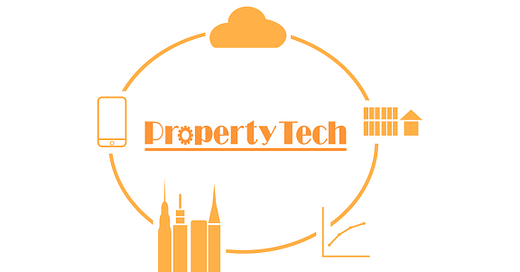What the hell is a smart building?
Pardon our French, but here is quick crash course to the 7 new smart techs
Introduction
Entire industries are whining about what prop tech (property tech) really means. It seems like all of these buzz words are becoming overused in real estate and are being hyped up more and more. So here’s a quick crash course on smart technologies in real estate to clarify what it means for landlords, investors, and tenants.
As you’ve probably heard before, the office is evolving.
Well, really the office has been evolving since the dot com era. Companies have shifted towards flex space for years. In the 90s, amenities became key for buildings to distinguish themselves from older commodities and to stay competitive with new construction projects. Amenities started out as a pretty revolutionary idea; cool perks gave employees easy access to restaurants, in-house gyms, outdoor space. It made them more functional and shifted the environment into a hospitable place that was simply more enjoyable. Since, landlords have continually developed curated experiences that become the calling card of the property. Over time, though, we have found that function and comfort keep employees engaged. Now we see progress in engagement through smart tech. The money seems to agree. According to byMarket Research Future, the smart building industry is expected to quadruple its previous market valuation of $7.45 billion in 2017 to $33.7 billion by 2023. Part of this explosion is driven by New York’s Local Law 97 (requiring all buildings 25,000+ SF to reduce greenhouse emissions by 40% by 2030 and 80% by 2050). Implementing new and creative tech can not only reduce costs and meet these emission standards, but also cater to our routines and make the office more functionable.
As a response, companies are starting to train property managers and hire tech & data integration specialists to install and operate smart tech in their buildings. Given that the post-covid office attendance is more fluid, each day requires a different demand of resources in electricity, heating, etc. Using technology to learn the behaviors helps save money and make the office environment more comfortable.
Tech companies started this trend to learn about their employee’s behavior. This prop tech helped tech companies in the hunt for talent and has slowly pressured more traditional industries (vying for a similar talent pool) to put in the seven key smart techs to reduce costs, pass those benefits onto their employees, and make their office feel more hospitable.
Here are the 7 Smart Building Technologies Needed to Bring Facilities into the Future
Smart buildings are loosely defined as a buildings that has an automated management and control over its operations. This is done through a network of sensors and microchips that gather data and convert them into insights.
1 - Internet of Things
IoT uses sensors to gather / analyze information and help deliver it to you. For example, you could put a sensor in the bathroom soap dispenser and when it is nearly empty you can schedule a refill with one click.
2 - Artificial Intelligence (AI) and Machine Learning (ML)
AI and ML use the Internet of Things to learn our behavior and pick up on abnormalities/look for inefficiencies. We can automate recurring tasks (temperature adjustments) or identify abnormalities (for example if a fridge starts to leak).
3 - Building Automation
Controlled by a website, Building Automation controls the HVAC system. It can pick up on patterns from foot traffic and, with AI, automatically allocate the right amount of heat/lighting/humidity/electricity while monitoring water/air quality and internet bandwidth optimization.
4 - Virtual Reality
VR offers the opportunity to tour buildings in a realistic, virtual environment that allows you to look at potential alterations and compare them in an instant.
This can also be used to be imported into facility management software and utilized for maintenance and upkeep.
5 - Augmented Reality
AR is a useful for analyzing unfamiliar wires and mechanical equipment. With smart glasses, AR tech can view digital notes “hovering” over each piece of equipment with ID tags, warnings, and troubleshooting solutions.
6 - Building Information Modeling
Building Information Modeling is a 3D model-based process used more and more by building managers. It is basically a building handbook that shows the locations of wires/circuits as well as their real-time power outputs to check for abnormalities.
7 - Drones
Drones, through AI, can automatically inspect shelves for expired products, hard-to-reach equipment, and other such tasks to become an eye that operates autonomously.
Our initial draft was ran a bit long, so we’ll cover what’s below and more in a subsequent issue(s):
How smart tech affects property value (Who is smart tech right for?)
Will sensor tech will reign in CRE (and will the sensor shortage limit its adoption?)
Smart tech for property managers
How does smart tech attract higher end tenants / what’s the benefit for tenants in a smart building
Smart tech can fulfill many of the little responsibilities required to keep the office functioning and comfortable. It learns what’s normal for the building and monitors for irregularities while allocating resources without us having to think about it. The tech improves traffic flow, temperature control, and resource usage. There is plenty of room for this industry to grow, and these are a few of the reasons we believe technology will soon become the leading improvement in office, industrial, and multifamily space. Subscribe to the Real Estate Views and News to learn more about what prop tech has to complete your knowledge on smart tech’s limitations, current issues, and areas for improvement.
Check out our Real Estate Views and News webpage
and feel free to contact the our CBRE team directly @
Taylor Callaghan, Senior Vice President
taylor.callaghan@cbre.com | 212 984 8272
Nicole Marshall, Associate
nicole.marshall@cbre.com | 212 984 6593
Graham Walter, Associate
graham.walter@cbre.com | 212 984 8059
What are your thoughts?
https://servicechannel.com/blog/7-smart-building-technologies/
https://cxre.co/real-estate-investment/smart-commercial-real-estate/#Office





